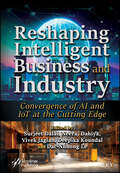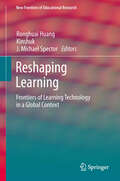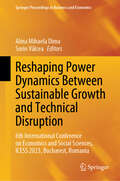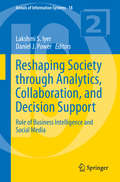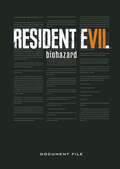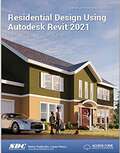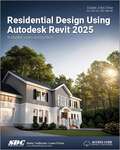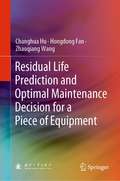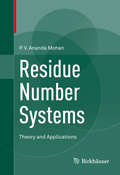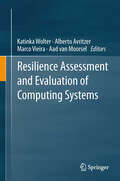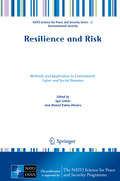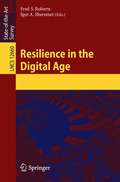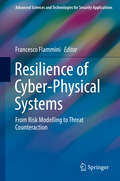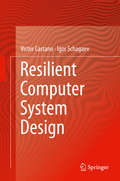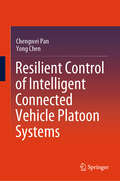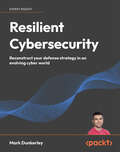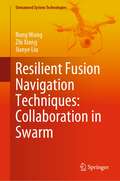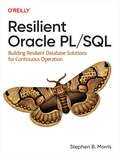- Table View
- List View
Reshaping Intelligent Business and Industry: Convergence of AI and IoT at the Cutting Edge
by Dac-Nhuong Le Surjeet Dalal Vivek Jaglan Deepika Koundal Neeraj DahiyaThe convergence of Artif icial Intelligence (AI) and Internet of Things (IoT) is reshaping the way industries, businesses, and economies function; the 34 chapters in this collection show how the full potential of these technologies is being enabled to create intelligent machines that simulate smart behavior and support decision-making with little or no human interference, thereby providing startling organizational efficiencies. Readers will discover that in Reshaping Intelligent Business and Industry: The book unpacks the two superpowers of innovation, AI and IoT, and explains how they connect to better communicate and exchange information about online activities; How the center and the network’s edge generate predictive analytics or anomaly alerts; The meaning of AI at the edge and IoT networks. How bandwidth is reduced and privacy and security are enhanced; How AI applications increase operating efficiency, spawn new products and services, and enhance risk management; How AI and IoT create ‘intelligent’ devices and how new AI technology enables IoT to reach its full potential; Analyzes AIOT platforms and the handling of personal information for shared frameworks that remain sensitive to customers’ privacy while effectively utilizing data. Audience This book will appeal to all business and organization leaders, entrepreneurs, policymakers, and economists, as well as scientists, engineers, and students working in artificial intelligence, software engineering, and information technology.
Reshaping Learning
by J. Michael Spector Kinshuk Ronghuai HuangThis edited volume with selected papers from extinguished experts and professors in the field of learning technology and the related fields who are far-sighted and have his/her own innovative thoughts on the development of learning technology. This book will addresses the main issues concerned with the trend and future development of learning processes, innovative pedagogies changes, effects of new technologies on education, future learning content. Learning technology has been affected by advances in technology development and changes in the field of education. Nowadays we cannot afford to sense the changes and then make adaption to it. What we should do is to predict the changes and make positive and active reactions to help the trend go smoothly and in a more beneficial way. This book aims to gather the newest ideas on the frontiers and future development of learning education from the aspects of learning, pedagogies, and technologies in learning in order to draw a picture of learning education in the near future.
Reshaping Power Dynamics Between Sustainable Growth and Technical Disruption: 6th International Conference on Economics and Social Sciences, ICESS 2023, Bucharest, Romania (Springer Proceedings in Business and Economics)
by Alina Mihaela Dima Sorin VâlceaThis book covers various topics related to economics and the social sciences, such as artificial intelligence, sustainability, ESG, and tax administration. The respective contributions provide insights and perspectives on the current challenges and opportunities in these fields, while also showcasing the latest research and innovations from scholars and practitioners around the world. The book is based on the papers presented at the 6th International Conference on Economics and Social Sciences, ICESS 2023, which was held in Bucharest, Romania.
Reshaping Society through Analytics, Collaboration, and Decision Support
by Daniel J. Power Lakshmi S. IyerThis volume explores emerging research and pedagogy in analytics, collaboration, and decision support with an emphasis on business intelligence and social media. In general, the chapters help understand where technology involvement in human decisions is headed. Reading the chapters can help understand the opportunities and threats associated with the use of information technology in decision making. Computing and information technologies are reshaping our global society, but they can potentially reshape it in negative as well as positive ways. Analytics, collaboration and computerized decision support are powerful decision aiding and decision making tools that have enormous potential to impact crisis decision making, regulation of financial systems, healthcare decision making and many more important decision domains. Many information technologies can potentially support, assist and even decide for human decision makers. Despite the potential, some researchers think that we know the answers to how these technologies will change society. The "Wisdom of Crowds" or "Big Data" become the topic of the day and are soon replaced with new marketing terms. In many ways, mobile technology is just another form factor to adapt decision support capabilities too and experiment with new capabilities. The cloud is a nebulous metaphor that adds to the mystery of information technology. Wireless technology enables the ubiquitous presence of analytics and decision support. With new networking capabilities, collaboration is possible anywhere and everywhere using voice, video and text. Documents can be widely shared and massive numbers of documents can be carried on a small tablet computer. Recent developments in technologies impact the processes organizations use to make decisions. In addition, academics are looking for ways to enhance their pedagogy to train students to be more adept in understanding how emerging technology will be used effectively for decision making in organizations. The chapters are based on papers originally reviewed at the Special Interest Group on Decision Support Systems (SIGDSS) Workshop at the 2013 International Conference on Information Systems (ICIS 2013). Ultimately this volume endeavors to find a balance between systematizing what we know, so we can teach our findings from prior research better, and stimulating excitement to move the field in new directions.
Reshaping Society through Analytics, Collaboration, and Decision Support: Role of Business Intelligence and Social Media (Annals of Information Systems #18)
by Daniel J. Power Lakshmi S. IyerThis volume explores emerging research and pedagogy in analytics, collaboration, and decision support with an emphasis on business intelligence and social media. In general, the chapters help understand where technology involvement in human decisions is headed. Reading the chapters can help understand the opportunities and threats associated with the use of information technology in decision making. Computing and information technologies are reshaping our global society, but they can potentially reshape it in negative as well as positive ways. Analytics, collaboration and computerized decision support are powerful decision aiding and decision making tools that have enormous potential to impact crisis decision making, regulation of financial systems, healthcare decision making and many more important decision domains.Many information technologies can potentially support, assist and even decide for human decision makers. Despite the potential, some researchers think that we know the answers to how these technologies will change society. The "Wisdom of Crowds" or "Big Data" become the topic of the day and are soon replaced with new marketing terms. In many ways, mobile technology is just another form factor to adapt decision support capabilities too and experiment with new capabilities. The cloud is a nebulous metaphor that adds to the mystery of information technology. Wireless technology enables the ubiquitous presence of analytics and decision support. With new networking capabilities, collaboration is possible anywhere and everywhere using voice, video and text. Documents can be widely shared and massive numbers of documents can be carried on a small tablet computer. Recent developments in technologies impact the processes organizations use to make decisions. In addition, academics are looking for ways to enhance their pedagogy to train students to be more adept in understanding how emerging technology will be used effectively for decision making in organizations.The chapters are based on papers originally reviewed at the Special Interest Group on Decision Support Systems (SIGDSS) Workshop at the 2013 International Conference on Information Systems (ICIS 2013). Ultimately this volume endeavors to find a balance between systematizing what we know, so we can teach our findings from prior research better, and stimulating excitement to move the field in new directions.
Resident Evil (Boss Fight Books)
by Phlip J ReedNow a sprawling video game franchise, Resident Evil has kept us on the edge of our seats for decades with its tried-and-true brand of jump scares, zombie action, and biological horror. But even decades after its release, we can&’t stop revisiting the original&’s thrills, chills, and sometimes unintentional spills. Pop culture writer and horror cinephile Philip J Reed takes dead aim at 1996&’s Resident Evil, the game that named and defined the genre we now call &“survival horror.&” While examining Resident Evil&’s influences from the worlds of film, literature, and video games alike, Reed&’s love letter to horror examines how the game&’s groundbreaking design and its atmospheric fixed-cam cinematography work to thrill and terrify players—and why that terror may even be good for you. Featuring a foreword from Troma Entertainment legend Lloyd Kaufman and new interviews with the game&’s voice actors and its live-action cast, the book serves as the master of unlocking the behind-the-scenes secrets of Resident Evil, and shows how even a game filled with the most laughable dialogue can still scare the pants off of you.
Resident Evil 7: Biohazard Document File
by CapcomAn in-depth, 152-page art book that ventures into the challenges recorded throughout the production of the critically acclaimed, fan-adored Resident Evil 7: Biohazard!Relive the terror of Resident Evil 7: Biohazard, the expertly crafted first-person survival horror game that altered the paradigm of Resident Evil titles. This art book includes undisclosed concept art and CG visuals closely arranged and coupled with detailed passages of the development team's progress on the game. Explore interviews, photo albums, a storyboard collection of in-game event scenes from opening to ending, and more in this succinctly packed chronicle of Resident Evil 7's development. Dark Horse Books and Capcom present Resident Evil 7: Biohazard Document Files, a perfect companion for fans of Resident Evil, and fully translated to English for the first time!
Resident Evil: Extinction
by Keith R. A. DecandidoFollowing the events of Resident Evil: Apocalypse, the beautiful, dangerous, enigmatic Alice returns, and this time she and her fellow survivor Carlos Olivera are running with a pack of humans led by a new ally, Claire Redfield. Together they are cutting through the wastelands of the United States on a long trek to Alaska. Hunted by the minions of the scheming Dr. Isaacs, Alice has zombies hungry for her flesh and the Umbrella Corporation's monstrous lab rats hungry for her blood...while Alice herself hungers only for revenge.
Resident Evil: Extinction
by Keith R. DecandidoFollowing the events of Resident Evil: Apocalypse, the beautiful, dangerous, enigmatic Alice returns, and this time she and her fellow survivor Carlos Olivera are running with a pack of humans led by a new ally, Claire Redfield. Together they are cutting through the wastelands of the United States on a long trek to Alaska. Hunted by the minions of the scheming Dr. Isaacs, Alice has zombies hungry for her flesh and the Umbrella Corporation's monstrous lab rats hungry for her blood...while Alice herself hungers only for revenge.
Residential Design Using Autocad 2022
by Daniel John StineResidential Design Using AutoCAD 2022 is an introductory level tutorial which uses residential design exercises as the means to teach you AutoCAD 2022. <p><p>Each book comes with access to extensive video instruction in which the author explains the most common tools and techniques used when designing residential buildings using AutoCAD 2022. After completing this book you will have a well-rounded knowledge of Computer Aided Drafting that can be used in the industry and the satisfaction of having completed a set of residential drawings.
Residential Design Using Autodesk Revit 2021
by Daniel John StineDesigned for users completely new to Autodesk Revit, this text takes a project based approach to learning Autodesk Revit’s architectural tools in which you develop a single family residence all the way to photorealistic renderings like the one on the cover. Each book also includes access to extensive video training designed to further help you master Autodesk Revit. The lessons begin with a basic introduction to Autodesk Revit 2021. The first four chapters are intended to get you familiar with the user interface and many of the common menus and tools. Throughout the rest of the book a residential building is created and most of Autodesk Revit’s tools and features are covered in greater detail. Using step-by-step tutorial lessons, the residential project is followed through to create elevations, sections, floor plans, renderings, construction sets, etc. Access to extensive video training is also included with your purchase of this book. These videos break down each topic into several short videos so that you can easily navigate to a specific aspect of a tool or feature in Autodesk Revit. This makes the videos both a powerful learning tool and convenient video reference. The videos make it easy to see the menu selections and will make learning Revit straightforward and simple. It’s like having the author by your side showing you exactly how to use all the major tools in Autodesk Revit.
Residential Design Using Autodesk Revit 2022
by Daniel John StineThis book is designed for users completely new to Autodesk Revit. This text takes a project based approach to learning Autodesk Revit’s architectural tools in which you develop a single family residence all the way to photorealistic renderings like the one on the cover. Each book also includes access to extensive video training designed to further help you master Autodesk Revit. The lessons begin with a basic introduction to Autodesk Revit 2022. The first four chapters are intended to get you familiar with the user interface and many of the common menus and tools. Throughout the rest of the book a residential building is created and most of Autodesk Revit’s tools and features are covered in greater detail. Using step-by-step tutorial lessons, the residential project is followed through to create elevations, sections, floor plans, renderings, construction sets, etc.
Residential Design Using Autodesk Revit 2025
by Daniel John StineResidential Design Using Autodesk Revit 2025 is designed for users completely new to Autodesk Revit. This text takes a project based approach to learning Autodesk Revit’s architectural tools in which you develop a single family residence all the way to photorealistic renderings like the one on the cover. Each book also includes access to extensive video training designed to further help you master Autodesk Revit. The lessons begin with a basic introduction to Autodesk Revit 2025. The first four chapters are intended to get you familiar with the user interface and many of the common menus and tools. Throughout the rest of the book a residential building is created and most of Autodesk Revit’s tools and features are covered in greater detail. Using step-by-step tutorial lessons, the residential project is followed through to create elevations, sections, floor plans, renderings, construction sets, etc.
Residual Life Prediction and Optimal Maintenance Decision for a Piece of Equipment
by Changhua Hu Hongdong Fan Zhaoqiang WangThis book addresses remaining life prediction and predictive maintenance of equipment. It systematically summarizes the key research findings made by the author and his team and focuses on how to create equipment performance degradation and residual life prediction models based on the performance monitoring data produced by currently used and historical equipment. Some of the theoretical results covered here have been used to make remaining life predictions and maintenance-related decisions for aerospace products such as gyros and platforms. Given its scope, the book offers a valuable reference guide for those pursuing theoretical or applied research in the areas of fault diagnosis and fault-tolerant control, remaining life prediction, and maintenance decision-making.
Residue Number Systems
by P. V. Ananda MohanThis new and expanded monograph improves upon Mohan's earlier book, Residue Number Systems (Springer, 2002) with a state of the art treatment of the subject. Replete with detailed illustrations and helpful examples, this book covers a host of cutting edge topics such as the core function, the quotient function, new Chinese Remainder theorems, and large integer operations. It also features many significant applications to practical communication systems and cryptography such as FIR filters and elliptic curve cryptography. Starting with a comprehensive introduction to the basics and leading up to current research trends that are not yet widely distributed in other publications, this book will be of interest to both researchers and students alike.
Resilience Assessment and Evaluation of Computing Systems
by Katinka Wolter Aad Van Moorsel Alberto Avritzer Marco VieiraThe resilience of computing systems includes their dependability as well as their fault tolerance and security. It defines the ability of a computing system to perform properly in the presence of various kinds of disturbances and to recover from any service degradation. These properties are immensely important in a world where many aspects of our daily life depend on the correct, reliable and secure operation of often large-scale distributed computing systems. Wolter and her co-editors grouped the 20 chapters from leading researchers into seven parts: an introduction and motivating examples, modeling techniques, model-driven prediction, measurement and metrics, testing techniques, case studies, and conclusions. The core is formed by 12 technical papers, which are framed by motivating real-world examples and case studies, thus illustrating the necessity and the application of the presented methods. While the technical chapters are independent of each other and can be read in any order, the reader will benefit more from the case studies if he or she reads them together with the related techniques. The papers combine topics like modeling, benchmarking, testing, performance evaluation, and dependability, and aim at academic and industrial researchers in these areas as well as graduate students and lecturers in related fields. In this volume, they will find a comprehensive overview of the state of the art in a field of continuously growing practical importance.
Resilience and Reliability on AWS: Engineering at Cloud Scale
by Jurg Van Vliet Flavia Paganelli Jasper GeurtsenCloud services are just as susceptible to network outages as any other platform. This concise book shows you how to prepare for potentially devastating interruptions by building your own resilient and reliable applications in the public cloud. Guided by engineers from 9apps—an independent provider of Amazon Web Services and Eucalyptus cloud solutions—you’ll learn how to combine AWS with open source tools such as PostgreSQL, MongoDB, and Redis.This isn’t a book on theory. With detailed examples, sample scripts, and solid advice, software engineers with operations experience will learn specific techniques that 9apps routinely uses in its cloud infrastructures.Build cloud applications with the "rip, mix, and burn" approachGet a crash course on Amazon Web ServicesLearn the top ten tips for surviving outages in the cloudUse elasticsearch to build a dependable NoSQL data storeCombine AWS and PostgreSQL to build an RDBMS that scales wellCreate a highly available document database with MongoDB Replica Set and SimpleDBAugment Redis with AWS to provide backup/restore, failover, and monitoring capabilitiesWork with CloudFront and Route 53 to safeguard global content delivery
Resilience and Risk
by Igor Linkov José Manuel Palma-OliveiraThis volume addresses the challenges associated with methodology and application of risk and resilience science and practice to address emerging threats in environmental, cyber, infrastructure and other domains. The book utilizes the collective expertise of scholars and experts in industry, government and academia in the new and emerging field of resilience in order to provide a more comprehensive and universal understanding of how resilience methodology can be applied in various disciplines and applications. This book advocates for a systems-driven view of resilience in applications ranging from cyber security to ecology to social action, and addresses resilience-based management in infrastructure, cyber, social domains and methodology and tools. Risk and Resilience has been written to open up a transparent dialog on resilience management for scientists and practitioners in all relevant academic disciplines and can be used as supplement in teaching risk assessment and management courses.
Resilience in the Digital Age (Lecture Notes in Computer Science #12660)
by Fred S. Roberts Igor A. SheremetThe growth of a global digital economy has enabled rapid communication, instantaneous movement of funds, and availability of vast amounts of information. With this come challenges such as the vulnerability of digitalized sociotechnological systems (STSs) to destructive events (earthquakes, disease events, terrorist attacks). Similar issues arise for disruptions to complex linked natural and social systems (from changing climates, evolving urban environments, etc.). This book explores new approaches to the resilience of sociotechnological and natural-social systems in a digital world of big data, extraordinary computing capacity, and rapidly developing methods of Artificial Intelligence. Most of the book’s papers were presented at the Workshop on Big Data and Systems Analysis held at the International Institute for Applied Systems Analysis in Laxenburg, Austria in February, 2020. Their authors are associated with the Task Group “Advanced mathematical tools for data-driven applied systems analysis” created and sponsored by CODATA in November, 2018. The world-wide COVID-19 pandemic illustrates the vulnerability of our healthcare systems, supply chains, and social infrastructure, and confronts our notions of what makes a system resilient. We have found that use of AI tools can lead to problems when unexpected events occur. On the other hand, the vast amounts of data available from sensors, satellite images, social media, etc. can also be used to make modern systems more resilient. Papers in the book explore disruptions of complex networks and algorithms that minimize departure from a previous state after a disruption; introduce a multigrammatical framework for the technological and resource bases of today’s large-scale industrial systems and the transformations resulting from disruptive events; and explain how robotics can enhance pre-emptive measures or post-disaster responses to increase resiliency. Other papers explore current directions in data processing and handling and principles of FAIRness in data; how the availability of large amounts of data can aid in the development of resilient STSs and challenges to overcome in doing so. The book also addresses interactions between humans and built environments, focusing on how AI can inform today’s smart and connected buildings and make them resilient, and how AI tools can increase resilience to misinformation and its dissemination.
Resilience of Cyber-Physical Systems: From Risk Modelling To Threat Counteraction (Advanced Sciences and Technologies for Security Applications)
by Francesco FlamminiThis book addresses the latest approaches to holistic Cyber-Physical System (CPS) resilience in real-world industrial applications. Ensuring the resilience of CPSs requires cross-discipline analysis and involves many challenges and open issues, including how to address evolving cyber-security threats. The book describes emerging paradigms and techniques from two main viewpoints: CPSs’ exposure to new threats, and CPSs’ potential to counteract them. Further, the chapters address topics ranging from risk modeling to threat management and mitigation. The book offers a clearly structured, highly accessible resource for a diverse readership, including graduate students, researchers and industry practitioners who are interested in evaluating and ensuring the resilience of CPSs in both the development and assessment stages. Foreword by Prof. Shiyan Hu, Chair of Cyber-Physical Systems at Linnaeus University, Sweden.
Resilient Computer System Design
by Igor Schagaev Victor CastanoThis book presents a paradigm for designing new generation resilient and evolving computer systems, including their key concepts, elements of supportive theory, methods of analysis and synthesis of ICT with new properties of evolving functioning, as well as implementation schemes and their prototyping. The book explains why new ICT applications require a complete redesign of computer systems to address challenges of extreme reliability, high performance, and power efficiency. The authors present a comprehensive treatment for designing the next generation of computers, especially addressing safety critical, autonomous, real time, military, banking, and wearable health care systems.
Resilient Control of Intelligent Connected Vehicle Platoon Systems
by Yong Chen Chengwei PanThe book focuses on the design of resilient control schemes for intelligent connected vehicle platoon systems. The issues of physical faults, malicious cyber-attacks and external disturbances are studied from the perspective of resilient control. The contents of this book introduce a variety of control schemes in detail, and give simulation or experimental verification cases. To enable readers to learn the resilient control methods of vehicle platoon systems is the main benefit of this book. Meanwhile, this book also benefits researchers, engineers, graduate students in related fields such as nonlinear control, robust control, resilient control, vehicle platoon control, etc.
Resilient Cybersecurity: Reconstruct your defense strategy in an evolving cyber world
by Mark DunkerleyBuild a robust cybersecurity program that adapts to the constantly evolving threat landscapeKey FeaturesGain a deep understanding of the current state of cybersecurity, including insights into the latest threats such as Ransomware and AILay the foundation of your cybersecurity program with a comprehensive approach allowing for continuous maturityEquip yourself with the strategies needed to build and manage an effective cybersecurity programBook DescriptionBuilding a Comprehensive Cybersecurity Program addresses the current challenges and knowledge gaps in cybersecurity, empowering individuals and organizations to navigate the digital landscape securely and effectively. Readers will gain insights into the current state of the cybersecurity landscape, understanding the evolving threats and the challenges posed today. This book emphasizes the importance of prioritizing well-being within the cybersecurity profession, addressing a concern often overlooked in the industry. You will construct a cybersecurity program that encompasses cybersecurity architecture, identity and access management, cybersecurity operations, vulnerability management, cybersecurity awareness, training, and testing, vendor risk management, and proactive services. It dives deep into managing Operational Technology (OT) & the Internet of Things (IoT), equipping readers with the knowledge and strategies to secure these critical areas. You will also explore the critical components of governance, risk, and compliance (GRC) within cybersecurity, focusing on the oversight and management of these functions. This book provides practical insights, strategies, and knowledge to help organizations build and enhance their cybersecurity programs, ultimately safeguarding against evolving threats in today's digital landscape.What you will learnBuild and define a cybersecurity program foundationDiscover the importance of why an architecture program is needed within cybersecurityLearn the importance of Zero Trust ArchitectureLearn what modern identity is and how to achieve itReview of the importance of why a Governance program is neededBuild a comprehensive user awareness, training, and testing program for your usersReview the importance of why a GRC program is needed Gain a thorough understanding of everything involved with regulatory and complianceWho this book is forThis book is geared towards the top leaders within an organization, C-level, CISO/CSO, directors, and program managers who build the strategy and execute the program. Cybersecurity managers, architects, engineers, administrators, analysts, and project managers who work in Cybersecurity would also benefit from this book. In addition, those who are still determining what they would like to do within cybersecurity can also benefit from this book by gaining an understanding of everything involved within a cybersecurity program. Basic knowledge of cybersecurity and its concepts will be helpful.
Resilient Fusion Navigation Techniques: Collaboration in Swarm (Unmanned System Technologies)
by Rong Wang Zhi Xiong Jianye LiuThis book describes the resilient navigation techniques under the background of collaboration in swarm. The significance of this work is that it focuses on the navigation enhancement by collaboration in swarm rather than ground infrastructure, which exploit potentialities of swarm in GNSS restricted environment. Although unmanned swarm is receiving greater attention, both through theoretical research and through increasing mention in the industrial developments, the navigation promotion by effective and efficient collaboration remains largely unexplored. While my scholarly work has explored some of the modeling, error characteristic, fusion algorithm, fault detection, and isolation aspects of the “adaptive navigation system” (such as the navigation system of robots and ground vehicles, aircrafts, aerospace vehicles, and unmanned aerial vehicles), the present book proposes the specialized investigation on the navigation with the resilient character, which could maintain the performance by essential collaboration with members in swarm in GNSS degradation environment. This book focused on the resilient navigation techniques under the background of collaboration in swarm. The key techniques of collaborative resilient navigation are proposed, including the collaboration framework, collaborative observation modeling, geometry optimization, integrity augmentation, and fault detection. The experiments are also carried out to validate the effectiveness of the corresponding techniques.
Resilient Oracle PL/SQL: Building Resilient Database Solutions for Continuous Operation
by Stephen B. MorrisAs legacy and other critical systems continue to migrate online, the need for continuous operation is imperative. Code has to handle data issues as well as hard external problems today, including outages of networks, storage systems, power, and ancillary systems. This practical guide provides system administrators, DevSecOps engineers, and cloud architects with a concise yet comprehensive overview on how to use PL/SQL to develop resilient database solutions.Integration specialist Stephen B Morris helps you understand the language, build a PL/SQL toolkit, and collect a suite of reusable components and patterns. You'll dive into the benefits of synthesizing the toolkit with a requirements-driven, feature-oriented approach and learn how to produce resilient solutions by synthesizing the PL/SQL toolkit in conjunction with a scale of resilience.Build solid PL/SQL solutions while avoiding common PL/SQL antipatternsLearn why embedding complex business logic in SQL is often a brittle propositionLearn how to recognize and improve weak PL/SQL codeVerify PL/SQL code by running data-driven, in-database testsUnderstand the safe operation, maintenance, and modification of complex PL/SQL systemsLearn the benefits of thinking about features rather than just use casesDefine good requirements for PL/SQL and hybrid solutions involving PL/SQL and high level languages
